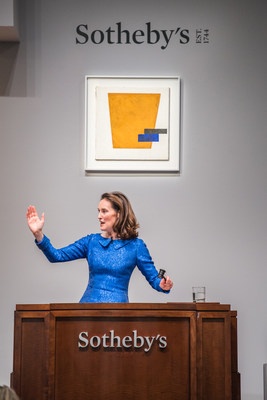NEW YORK, Dec. 5, 2017 /PRNewswire/ --�One year ago today, Sotheby's (NYSE: BID) announced the acquisition of Orion Analytical, the leading materials analysis and consulting firm in the art world, and hired its founder, Jamie Martin, to establish a Department of Scientific Research.� It was the first � and still only � department of its kind in the auction world.� In just one year, dramatic progress has been made in the integration of science and technology with the world-class expertise and provenance research behind the works of art, objects and wine offered by Sotheby's.

Jamie Martin, Director of Sotheby's groundbreaking Department of Scientific Research, commented: "It's been an incredibly energizing year for me at Sotheby's. I'm particularly inspired by my work with specialists worldwide � it is the combination of their art historical knowledge with our laboratories' analysis that has led to our most impactful determinations. In 2018 I look forward to expanding our capabilities both geographically and into a greater variety of materials, as Sotheby's world affords us access to the very best of fine art, furniture, wine and beyond."
State-of-the-art laboratory opened in Sotheby's New York headquartersOnly the 4th laboratory in the United States,Alongside Metropolitan Museum of Art, National Gallery of Art and J. Paul Getty Museum,To Acquire a Bruker M6 Jetstream: Revolutionary German X-Ray Fluorescence TechnologyThat Maps the Composition of Works
Facility in London Opened to Serve the United Kingdom and Continental EuropePlans to Establish a Similar Facility in Hong KongPortable Capability Available for Worldwide Use
Collaboration with Sotheby's Specialists Across 15 Different Collecting Categories in New York, London, Paris, Geneva and Hong KongTo Examine Hundreds of Paintings, Works on Paper, Bronze and Stone Sculpture,Furniture and Wine Valued at More than $100 Million� Investigating Construction, Composition, and Condition andProviding Leads for Attributions and Dispute Resolutions �
Additional Staff Recruited Including:Technical Art Historian & Research Coordinator, Assistant Conservation Scientist andLondon Project Administrator
CASE STUDYMaterials analysis revealed an unusual blue paint in Kazimir Malevich's painting Suprematist Composition with Plane in Projection, and infrared photography revealed changes the artist made in the composition at an earlier stage.
Further research into the blue paint led the Sotheby's Scientific Research Department to another painting by the artist in the collection of the Art Institute of Chicago: Painterly Realism of a Football Player � Color Masses in the 4th Dimension, 1915. Not only did both works contain the same blue paint additive (basic magnesium carbonate); both paintings also revealed changes Malevich made to the compositions throughout the execution process.
The analysis conducted by Scientific Research Department, together with provenance research conducted by specialists in Sotheby's Impressionist & Modern Art Department, provided insight into unique materials and creative processes, lending physical evidence in support of the art historical understanding of the painting and the artist's greater oeuvre.�
Suprematist Composition with Plane in Projection, 1915 was sold at Sotheby's in New York on May 16, 2017 for $21.2 million after a prolonged battle between four bidders � topping its $18 million high estimate, and marking the 4th-highest auction price for Kazimir Malevich.
About Sotheby's Twitter: www.twitter.com/sothebys�Instagram: www.instagram.com/sothebys��Facebook: www.facebook.com/sothebys�Snapchat ID: sothebysYouTube: www.youtube.com/SothebysTV��Weibo: www.weibo.com/sothebyshongkong�WeChat ID: sothebyshongkong
Sotheby's has been uniting collectors with world-class works of art since 1744. Sotheby's became the first international auction house when it expanded from London to New York (1955), the first to conduct sales in Hong Kong (1973), India (1992) and France (2001), and the first international fine art auction house in China (2012). Today, Sotheby's presents auctions in 10 different salesrooms, including New York, London, Hong Kong and Paris, and Sotheby's BidNow program allows visitors to view all auctions live online and place bids from anywhere in the world. Sotheby's offers collectors the resources of Sotheby's Financial Services, the world's only full-service art financing company, as well as the collection advisory services of its subsidiary, Art Agency, Partners.� Sotheby's presents private sale opportunities in more than 70 categories, including S|2, the gallery arm of Sotheby's Global Fine Art Division, and two retail businesses, Sotheby's Diamonds and Sotheby's Wine. Soth eby's has a global network of 80 offices in 40 countries and is the oldest company listed on the New York Stock Exchange (BID).
Browse sale catalogues, view original content, stream live auctions and more at www.sothebys.com, and through Sotheby's apps for iPhone, iPad, Android, Apple TV and Amazon Fire.
New York | +1 212 606 7176 | Lauren Gioia | [email protected] | Dan Abernethy | [email protected]�London | +44 207 293 6000 | Mitzi Mina | [email protected]
View original content with multimedia:http://www.prnewswire.com/news-releases/sothebys-department-of-scientific-research-celebrates-first-anniversary-300566695.html
SOURCE Sotheby's
Copyright 2014 PR Newswire. All Rights Reserved
Related Keywords:Computers/Peripherals,Notebook/Laptop,Tablets,Computers/Home Office,Communications,Digital Photography,Digital Audio,Digital Toys,Tablets,Networks,Handheld,iPhone,tablet,Technology,iPods,iphone,iPad,Tablet,iPhone,Mac,Android,OS9,OSX,Apple Computer,Sports,
Source:PR Newswire. All Rights Reserved
Source:
Sotheby's Department Of Scientific Research Celebrates First Anniversary





 A painting by Kazimir Malevich is analyzed to help determine its authenticity.
A painting by Kazimir Malevich is analyzed to help determine its authenticity. 














